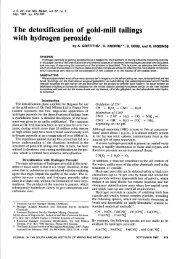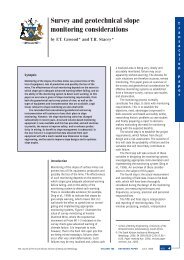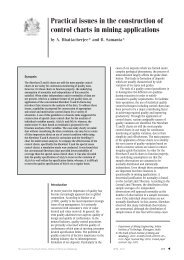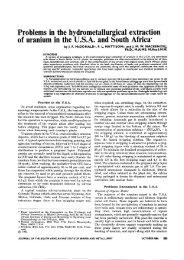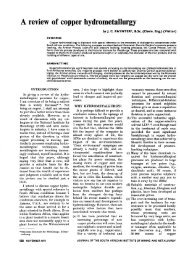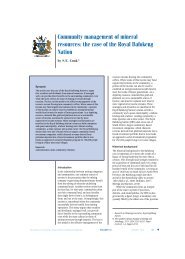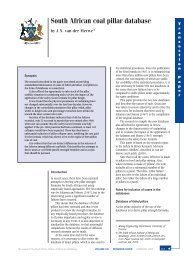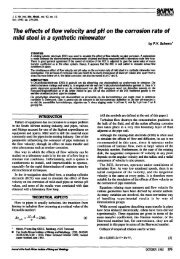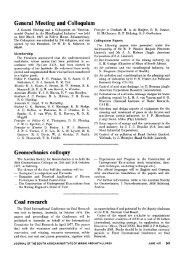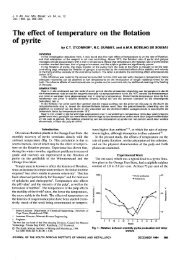The chemical behaviour of cyanide in the extraction of gold ... - saimm
The chemical behaviour of cyanide in the extraction of gold ... - saimm
The chemical behaviour of cyanide in the extraction of gold ... - saimm
Create successful ePaper yourself
Turn your PDF publications into a flip-book with our unique Google optimized e-Paper software.
0,6<br />
0,5<br />
Temperature<br />
.. 5 °C<br />
)(<br />
20 °C<br />
. 30°C<br />
0,6 0 2,3 mg 02/1; N2 bubbl<strong>in</strong>g<br />
. 6,5 mg O2/1; No gas bubbl<strong>in</strong>g<br />
0,5<br />
-------<br />
0 15 mg O2/1; O2 bubbl<strong>in</strong>g<br />
.. > 20 mg 02/1; 02 bubbl<strong>in</strong>g<br />
--......-<br />
----...<br />
.. ..<br />
0,4<br />
~ 0,3<br />
zU t.s<br />
2:.<br />
0,2<br />
0,4<br />
::::::<br />
co<br />
~ 0,3<br />
t.s<br />
2:.<br />
0,2<br />
0<br />
0,1<br />
Q)<br />
..c::<br />
tJ e<br />
t.s .-<br />
Q) ....<br />
Q)<br />
-t.s tJ c::: Q)<br />
.:!<br />
~ f-o ~<br />
0<br />
0 10 20 30<br />
Time, h<br />
Conditions<br />
Volume <strong>of</strong> solution 500ml<br />
pH 10,2<br />
02 <strong>in</strong> solution 6,5 mg/I<br />
Fig. 4-Effect <strong>of</strong> temperature on <strong>the</strong> stability <strong>of</strong> <strong>cyanide</strong><br />
40<br />
0,1<br />
Q)<br />
tJ<br />
-t.s<br />
"5 e<br />
~ .;:<br />
c:::<br />
tJ Q)<br />
0. .-<br />
.- "0<br />
f-o<br />
» '" ~<br />
0<br />
50 0 10 20 30 40 50<br />
Time, h<br />
Conditions<br />
Volume <strong>of</strong> solution 500ml<br />
pH 10,2<br />
Fig. 5-Effect <strong>of</strong> <strong>the</strong> concentration <strong>of</strong> oxygen on<br />
<strong>the</strong> stability <strong>of</strong> <strong>cyanide</strong> at 20°C<br />
<strong>The</strong> actual extent <strong>of</strong> <strong>the</strong> decomposition <strong>of</strong> <strong>cyanide</strong> that<br />
is <strong>in</strong>herent <strong>in</strong> various elution procedures has not, as yet,<br />
been firmly established. Fig. 8 shows <strong>the</strong> results for <strong>the</strong><br />
loss <strong>of</strong> <strong>cyanide</strong> <strong>in</strong> <strong>the</strong> pre-treatment stage <strong>of</strong> an elution<br />
process developed by Anglo American Research Laboratories<br />
and known as <strong>the</strong> AARL process. A significant loss<br />
<strong>of</strong> <strong>cyanide</strong> is evident after 30 m<strong>in</strong>utes <strong>of</strong> pre-treatment,<br />
particularly at higher temperatures. (At l30°C, 80 to 90<br />
per cent <strong>of</strong> <strong>the</strong> <strong>cyanide</strong> has decomposed.) In fact, several<br />
processes have been reported9,1Ofor <strong>the</strong> destruction <strong>of</strong><br />
<strong>cyanide</strong> <strong>in</strong> aqueous waste solutions by <strong>the</strong>rmal decomposition<br />
techniques.<br />
<strong>The</strong> experiments used here differ from those used<br />
earlier <strong>in</strong> this work, <strong>in</strong> that <strong>the</strong> elution conditions were<br />
simulated. A typical solution was chosen, composed <strong>of</strong><br />
0,2 M sodium <strong>cyanide</strong> and 0,2 M sodium hydroxide, and<br />
hav<strong>in</strong>g a solution volume <strong>of</strong> 300 ml and a carbon concentration<br />
<strong>of</strong> 89 g/1. <strong>The</strong>se conditions are exactly <strong>the</strong> same<br />
as those used <strong>in</strong> previous work on <strong>the</strong> k<strong>in</strong>etics <strong>of</strong> <strong>the</strong> elution<br />
<strong>of</strong> <strong>gold</strong> from activated carbonll, and <strong>the</strong>y afford an<br />
easy comparison between <strong>the</strong> decomposition <strong>of</strong> <strong>cyanide</strong><br />
and <strong>the</strong> elution <strong>of</strong> <strong>gold</strong> under <strong>the</strong> same conditions.<br />
In <strong>the</strong> preced<strong>in</strong>g paper!, it was shown that <strong>the</strong> loss <strong>of</strong><br />
<strong>cyanide</strong> at 95°C, <strong>in</strong> both <strong>the</strong> presence and <strong>the</strong> absence<br />
<strong>of</strong> activated carbon, is due to <strong>the</strong> hydrolysis <strong>of</strong> <strong>cyanide</strong><br />
to ammonium<br />
formate:<br />
CN- + 2 HP - NH3 + HCO;. (3)<br />
<strong>The</strong> <strong>in</strong>stability <strong>of</strong> formate at higher temperatures<br />
<strong>in</strong> <strong>the</strong> follow<strong>in</strong>g overall reaction:<br />
results<br />
CN- + 3 HP - NH3 + CO2 + H2 + OH-. (4)<br />
Fig. 9 shows <strong>the</strong> dramatic effect <strong>of</strong> an <strong>in</strong>crease <strong>in</strong><br />
temperature from n to 95°C. At 95°C, about 93 per cent<br />
<strong>of</strong> <strong>the</strong> <strong>cyanide</strong> decomposed <strong>in</strong> 50 hours (<strong>the</strong> typical time<br />
taken for a Zadra elution at 95°C), whereas less than 30<br />
per cent was lost at noc over <strong>the</strong> same time period. Even<br />
if <strong>the</strong> actual residence time <strong>of</strong> <strong>the</strong> eluant <strong>in</strong> <strong>the</strong> column<br />
is taken to be half this <strong>in</strong> total, a loss <strong>of</strong> about 85 per<br />
cent <strong>of</strong> <strong>the</strong> <strong>cyanide</strong> can be expected. <strong>The</strong> use <strong>of</strong> a pressurized<br />
elution vessel will result <strong>in</strong> an even greater loss<br />
<strong>of</strong> <strong>cyanide</strong> (Fig. 8).<br />
<strong>The</strong> presence <strong>of</strong> activated carbon had little effect on<br />
<strong>the</strong> loss <strong>of</strong> <strong>cyanide</strong> at 95°C, except <strong>in</strong> <strong>the</strong> <strong>in</strong>itial stages,<br />
whereas at noc a marked <strong>in</strong>crease <strong>in</strong> <strong>the</strong> loss <strong>of</strong> <strong>cyanide</strong><br />
was evident with activated carbon.<br />
Despite <strong>the</strong> <strong>in</strong>crease <strong>in</strong> <strong>the</strong> rate <strong>of</strong> <strong>cyanide</strong> loss with an<br />
<strong>in</strong>crease <strong>in</strong> temperature, <strong>the</strong> actual amount <strong>of</strong> <strong>cyanide</strong><br />
consumed <strong>in</strong> <strong>the</strong> elution stage for a given amount <strong>of</strong> ore<br />
70 MARCH 1990 JOURNAL OF THE SOUTH AFRICAN INSTITUTE OF MINING AND METALLURGY




